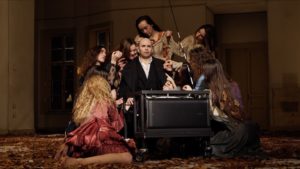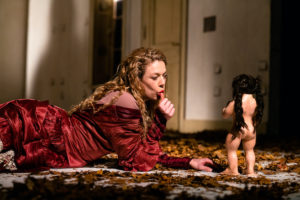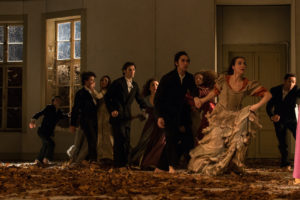Tanztheater Wuppertal Pina Bausch: Pina Bausch / Bluebeard - Vancouver Ballet Society
- Home
- Reviews 2020 - 2023
- Tanztheater Wuppertal Pina Bausch: Pina Bausch / Bluebeard

Pina Bausch’s Bluebeard. While Listening to a Tape Recording of Béla Bartók’s “Duke Bluebeard’s Castle” premiered in 1977, just four years after she became artistic director of Tanztheater Wuppertal. In January, at Opernhaus Wuppertal, the show was restaged for the first time since 1994, the long delay due to difficulties over music rights.
The cast of Bluebeard was bolstered by guest artists and students from Folkwang University of the Arts, where Bausch herself trained and later taught. Dancers and former dancers from Tanztheater Wuppertal often teach there, giving the students some grounding in Bausch vocabulary.

A few elements onstage: a chair, a tape recorder attached to the ceiling with a flexible leash, old dresses and a carpet of dried brown leaves (set design by Rolf Borzik). The piece begins dramatically with a recording of Bartók’s opera as Judith (Tsai-Chin Yu) lies stiffly on the leaves in a dark rose dress with arms and hands bent upwards to welcome her lover, Bluebeard (Oleg Stepanov), who tenderly throws himself in her arms. Their duet is brutally interrupted when an aria begins and Bluebeard quickly stands up to rewind the tape back to the melody, an action that is obsessively repeated over and over.
Pathos reigns with the arrival of a long line of dancers entering one by one in a human chain, heads bowed. The women wear long, colourful and elegant dresses, the men are in tuxedos, as in many Bausch creations. Very often, as the ensemble screams, cries, pants, mourns and laughs hysterically, their pain is palpable, their bewilderment piercing. When the men and women dance together, slow and detached, they seem neither interested in nor respectful toward each other.
Cries turn into annoying lullabies or animal noises. The women shout, “Lieb mich” (Love me) like cats in heat or “Danke dir” (Thank you) like tedious coquettes. While they cling to Bluebeard, Judith screams, “Weil ich dich liebe!” (Because I love you!) in a desperate attempt to be heard.
The two main characters are complex: Bluebeard seems torn between being an attentive, caring lover and a man who is overtaken by his own insecurities and obsessions. He looks like someone who doesn’t know how to act differently, or how to be better. Judith is the suffering observer, watching the violent and absurd way the others relate; they could be her enemies or her alter egos. She is an act of resistance, but also the victim of a love that cannot be controlled and of desires that cannot be suppressed.
Violence is recurrent. Women and men seem incapable of finding common ground. The men’s allure over the women is baffling considering how they impose themselves by brutal force. Men push the women’s heads down to make them fall at their feet as if to denigrate and make them submit. The women look oppressed and incapable of counterattack, but both genders are suffering, both are lost. As in the general oeuvre by Bausch, the dynamics between men and women and the complexity of relationships are deeply investigated. What is different from the other pieces is the violence and cruelty of the men over the women. We can probably assume that Bausch, working in the 1970s, felt it urgent to create a piece denouncing the repression and mistreatment of women.

At one point, a little naked doll with long hair is brought onstage by one of the women (Emma Barrowman) and becomes an idol. Watching her flirtation as she touches her lips while smiling at the doll, while the self-indulgent Bluebeard poses and shows off his muscles in front of it, I found myself pondering the concept of adulation and the outcomes of hedonism.
The dried leaves on the floor that rustle and break down under the movements of the performers are a perfect metaphor of the fragility of love and difficulty of relationships, which are the key themes of the piece.
Both Stepanov and Yu are outstanding dancers. She is extremely flexible with a marvellous capacity to embody the long, beautiful and expressive lines of Bausch language. Yu appears to be deeply moved by the role of Judith, a woman madly in love with a man incapable of loving her back the same way, her solitude and desperation apparent in her suggestive movements and expressions. Stepanov is very precise, not only regarding his movements and in perfectly embodying the complex figure of Bluebeard, but also in leading the tempo in a piece that is based on his constantly interrupting and rewinding the Bartók opera.
I couldn’t help but wonder what this remounted Bluebeard would have been like if Bausch were still alive. Although well-staged by Beatrice Libonati and Jan Minarik, former Tanztheatre Wuppertal dancers, it seemed that more time was needed to imprint the Bausch style and spirit into the new dancers, both the guests performers and the Folkwang dance students. Despite their accurate execution of the roles, they seemed not to be fully capable of bringing onstage the magic of the characters of Bausch masterpieces.
—VERONICA POSTH

